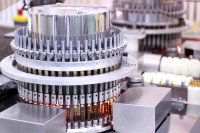Categories
- Additional Insured
- ChildrensProducts
- Claims Made
- Cyber Insurance
- Dietary Supplements and Nutraceuticals
- Ecigarettes
- Firearms Insurance
- Food Products
- Foreign Products Liability
- Foreseeable Misuse
- Frivolous Lawsuits
- General Liability
- Industrial
- Infographics
- Intellectual Property
- Looking ahead
- Marijuana Liability
- Medical Products
- Mutual Indemnification
- Nano Technology
- News
- Online Sellers Insurance Requirements
- Outsourcing
- Piercing The Corporate Veil
- Pollution Liability
- Product liability
- Product Recall
- Retail Chain Store
- Start-Up Business
- Statute of Repose
- Surplus Lines Insurance
- Technology
FDA Looking to Improve Safety of Imports

Cooperation recommended for foreign agencies
Food and drug regulators in the U.S., Europe and other developed countries are facing an increasingly difficult task. They have to make sure that the imports from 300,000 foreign facilities in 150 different countries are safe. Recent reports by the Governmental Accountability Office(GAO) report that the FDA inspected less than 11% of the manufacturing plants on its own list of high-priority sites. This presents a problem since 80% of pharmaceutical ingredients and 85% of seafood are foreign imports.
Recent scares of contaminated seafood, baby formula, pet food and blood-thinning drugs from China has the FDA scrambling for solutions. This true for the increase in counterfeit drugs, such as the popular cancer drug Avastin, penetrating the market .
International cooperation is critical
A panel assembled by the Institute of Medicine recommended that the U.S., Europe, Canada and Japan create a system for sharing the inspection duties for facilities in developing countries. There apparently is currently no cooperation between the various agencies regarding inspections. This is a set-up for potential overlaps in examining the same facilities. The panel also recommended regulators in the U.S., Europe and other developed countries offer training, technology and expertise to developing nations.
With all the recent problems that come with a global economy, cooperation across borders is a must to ensure the safety of our food and medical products. Unfortunately, changes will likely be slow since most of the changes required are by governmental agencies.
Posted By: Paul L. Owens-
 Click the Button Below to Get Your
Click the Button Below to Get Your
No-Obligation Quotes from Among the
Top 18 Leading Insurance Carriers Today -
Recent Industry News
- Amazon Sellers and Vendors Strategy Including Insurance Requirements
- Walmart Sellers Insurance
- Product Liability Limit Requirements of Online Sellers
- State-by-State Product Liability Analysis of Laws Impacting Businesses
- Children’s Product Liability: Strange Claims and Need for Insurance
- Product Liability vs. Environmental Insurance for the Chemical Industry
- Product Liability in the 3D Printing Industry: New Materials and Their Significance
- Product Liability Concerns in Agricultural Equipment Enhanced with Artificial Intelligence
- Navigate Product Liability in Battery and Solar Industry
- Cyber Risk Insurance Is Essential Business Insurance in Today’s Modern World
Monthly News Archives
